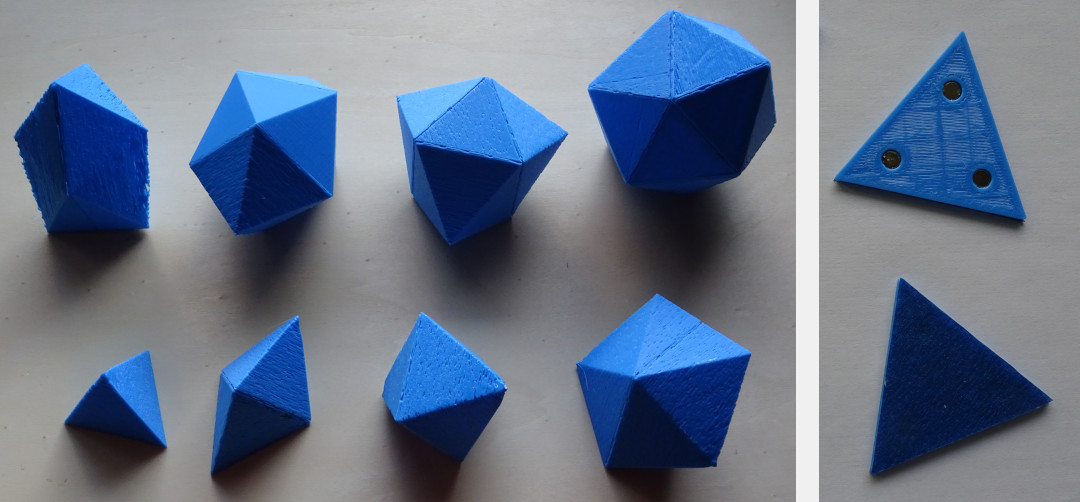

In the following table you can click the total number of given triangles to get some constructions where sets of deltahedrons are covered with these pieces. For short only the numbers of faces of the deltahedrons is listed. If you click the pictures, you can turn the sets around to look at the deltahedrons from different positions.
| Number of Triangles | Properties of Edges | Sets of Deltahedrons |
|---|---|---|
| 20 | 5 possible colors, all edges different |
Single Icosahedron (20) 8+12 6+14 4+16 4+6+10 |
| 24 | 4 possible colors | 4+20 8+16 10+14 4+8+12 4+6+14 6+8+10 |
| 40 | 6 possible colors, all edges different |
4+10+12+14 4+16+20 6+14+20 8+12+20 10+14+16 4+6+10+20 4+6+14+16 4+6+8+10+12 4+8+12+16 |
| 5 possible colors, not all edges equal |
||
| 70 | 7 colors, all edges different |
4+6+10+14+16+20 4+8+10+12+16+20 6+8+10+12+14+20 8+12+14+16+20 4+6+8+10+12+14+16 |
| 76 | 6 possible colors | 4+6+8+10+12+16+20 4+10+12+14+16+20 6+8+12+14+16+20 |
| 90 | 5 possible colors at 2 positons, exactly 2 edges equal |
all deltahedrons |
To get a physical puzzle I printed the eight deltahedrons. Here are the obj-files for these solids. I split the whole solids into two or more parts to avoid support for overhangs. Then I printed triangles with three holes for little magnets of sizs 5mm x 2mm and fixed the magnets by sticking adhesive tape on the triangles.

At last I used stickers on the tape to indicate the colors of the edges. I used this appraoch to construct two-sided triangles, which can be turned upside down and placed on the deltahedrons. For this purpose I attached iron foil on the faces of the printed deltahedrons. But I got gaps between the triangles on the deltahedron due to the thickness of the pieces. Furthermore I ran out of magnets.
So I decided to make triangles out of magnetic foil and stickers made out of foam rubber. An example is shown in the title. But you cannot turn these pieces upside down because of the thickness of the stickers. Therefore only one-sided constructions are listed in the table above.
Here are only three virtual examples for two-sided constructions. Click the pictures to rotate or move the sets.
With three available colors you get 10 different two-sided pieces and you can cover the deltahedron with 10 faces or two deltahedrons with 4 and 6 faces.
With four colors we have 20 two-sided pieces and 20*3/4=15 same colored edges. This is an odd number of edges not suitable for matching edges.
With five colors there are 35 two-sided pieces with 35*3/5=21 same colored edges and the above argument holds as well.
With six colors we have 56 two-sided pieces pieces and four deltahedrons with 6, 14, 16 and 20 faces can be covered. Solving this problem was not that hard but lasted a few seconds longer than the problems with one-sided pieces, which showed up immediately.
With 7 available colors and 84 two-sided pieces pieces a set of all deltahedrons without the triangulal dipyramid can be covered.